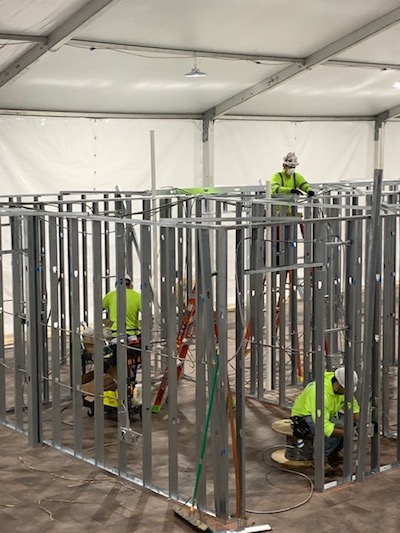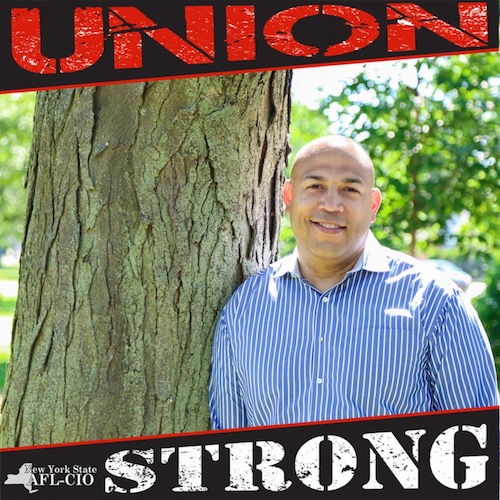The Virus erupted in Westchester County when cases in neighboring New York City were still in the single digits.

|
|
Local 3 members at work on hospital rooms inside the Westchester County Center, which were built from the studs up and fully framed.
|
It was the first week of March. Lou Sanchez, a business representative in Local 3’s White Plains office and 20-year member, was interviewing political candidates looking for union endorsements when his wife called.
“A teacher she shares a classroom with tested positive — same room, same computer,” Sanchez said. “We quarantined at home for 14 days. Luckily no one got sick.”
But thousands of county residents rapidly did. On March 22, the Westchester County Center was one of four sites Gov. Andrew Cuomo designated for overflow hospitals, telling the Army Corps of Engineers to forge ahead, “no red tape.” The Javits Center and two Long Island sites were the others, all employing IBEW members.
In just three weeks, Local 3 crews and their building trades brothers constructed 110 rooms from the studs up, half inside the Westchester pavilion and the rest in tents outside.
“They knew it would be dangerous to put 100 guys there, so they broke it up into 12-hour shifts around the clock,” Sanchez said. “Everyone had their N95 masks, gloves, there was Purell everywhere. They were given their own space to work. Everyone was really proud to be there”
So far the beds haven’t seen patients. By late April, with area residents’ strict adherence to safety protocols and stay-at-home orders, Covid-19 cases had dropped significantly in Westchester County. The rooms are being used for testing and will stay in place in case of a second wave of the virus this fall.
Sanchez worked at home while quarantined and cautiously returned to the office afterwards. He’s getting more members back to work every week, and said some projects never shut down. A high-rise under construction in White Plains was deemed essential, for instance, because it includes desperately needed affordable housing.
“The Alimak only takes up four people at a time,” he said, describing safety measures. “They mandated the north staircase as up only, and the other side is down only.”
There, and at White Plains Hospital where an extension was underway before the crisis, workers arrive at staggered times and don’t enter until a laser scanner aimed at their foreheads confirms they don’t have a fever. Sanitation is meticulous.

|
|
Local 3 business representative Lou Sanchez, using a Facebook frame to show his union pride, had to quarantine at home for 14 days after his wife’s possible exposure to COVID-19 in early March. The family lives in Westchester County, site of the state’s first major outbreak.
|
“There are guys with backpacks, like what painters use to spray paint on walls,” Sanchez said. “They converted them and put in a bleach solution. They walk around spraying everything.”
As Westchester worked to contain its outbreak, cases skyrocketed to the south in New York. The world saw media reports of overwhelmed ERs, ICUs, and supply shortages that forced many nurses to reuse PPE that they’d normally discard between each patient.
On a labor conference call, Sanchez learned that a charity in Yonkers had supplies, but not enough hands to distribute them. “Usually they have retired nurses who volunteer, but all those retired nurses got called back to the work,” he said.
The Afya Foundation was created to ship protective gear and other equipment to medical workers in some of the world’s poorest countries. Now PPE was stacking up its warehouse, while New York City and other U.S. hotspots were in dire need
Sanchez pledged to deliver Local 3 members if the Afya could ease its requirement that volunteers have medical training. It did. Over several shifts, they sorted, counted and packed gowns, surgical masks, gloves, booties and more. “We shipped out thousands of pieces of PPE to local hospitals,” he said.
His job is as busy as ever, but the pandemic has curtailed late nights “at a million different meetings,” giving him more family time. Instead of testifying at public hearings and other obligations on his pre-Covid calendar, “I can be home at 6 o’clock cooking dinner and playing Twister with my kids.”
It gives his wife, a middle-school Spanish teacher, a little breathing space. “My wife, I feel so bad for her.,” he said. “I’ve been fortunate to be able to come back to the office. She’s at home dealing not only with our two children but all her students. I come home with flowers often.”